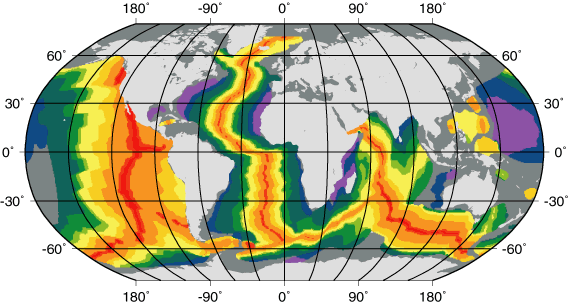keeha wrote: link ...the lower mantle—a region some 400 to 1,800 miles (660 to 2,900 kilometers) below the surface...
"Our results show that the conductivity of heat in this part of the lower Earth is driven by the amount of ferric iron in the mantle and the process of losing and gaining electrons,"
I think I see where you're going with this.
- When the Earth gets hit again by a major plasma event the Pacific plate will start to split too, possibly at the hot spots.
I think you are right. The articles you mention talk about iron in the crust at key points and an increase in electron flow. There are many TPODs that mention nucleosynthesis of silicon into iron, so I can see that if a plasma strike hits an area and goes deep that you would not just have crust rise up in a blister, but you'd also have the amount of iron increase, changing conductivity, helping pump more energy into the crust at that point.
Neal Adams has a few examples of how the planets grow, with the new crust cooling into plates and then those plates breaking over time.
- Cool plates
splitting into new.
- Old crust forming
mountains and then splitting.
- A
large plate splitting up into many pieces.
Stuff like this is mentioned in the book
Carl Sagan and Immanuel Velikovsky, by Charles Ginenthal, they talk about mountain building. Around page 125-126 they mention Darwin's observations about the Andes, how he found what looks like a brand new coastline.
- BTW, I'll be glad when the e-book version is available (hint, hint, to Mikamar Publishing) so that it is easier to search and find stuff, and add notes. (Adobe is great for making searchable notes in an e-book. But I digress .)
That brings me to a key question that needs to be answered.
- How much did the Earth grow during the Saturn Event.
Different groups talk about how the sky has radically changed in the past ten thousand years, and that we need to understand that to put Earth history into context. If the Earth grew as well, then everything changes.
We look at the Earth now and make assumptions about population movements, who was in contact with each other, wonder how the Pacific islands were settled, all based on the Earth as it is now. Now step through the end of the
video, where he is showing both sides of the Earth, and see how close everything was at different points in the growth and think about:
- Places like Easter Island may not have been out in the middle of nowhere. The people may have been deserted by events.
- I don't want to get all New Agey when I mention Atlantis--I don't want to lose everybody by talking about "Atlantis", after all it's just a myth, right?--but if the Earth grew during the Saturn Event then the stories about Atlantis could simply be descriptions of the Americas when they were closer to Europe and parts of it were below sea level. When the boats that normally traded with "Atlantis" went out they didn't find the destination and decided that it must have sunk beneath the waves.
The work that
Thor Heyerdahl did trying to recreate the routes of
ancient mariners would make more sense on a smaller Earth. Many of the legends, pre-Saturn Event, make more sense on a smaller Earth, and we need to put them into that perspective.
You may have heard this phrase before.
- When you only have a hammer, then you use that hammer for everything.
When you watch the Neal Adams videos, notice that he doesn't know about the stuff being done by the EU/plasma cosmology people, so he is missing pieces of the puzzle.
- The Eu group sees plasma cutting to form craters and large formations, the GET group sees planet growth and meteor impacts to describe things.
- The Saturn Events group use the sky changing to explain history, the GET group use the Earth growing to explain events.
I'll be glad when everybody starts using all the "tools" and they begin building something great.
I'll end with this great slow motion look at the
growing Earth.
As always, read the links and make up your own mind.



